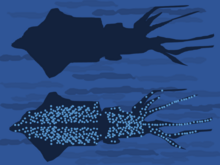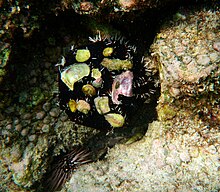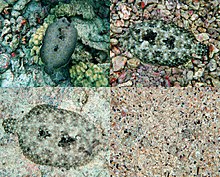Underwater camouflage
Underwater camouflage is the set of methods of achieving
Camouflage in relatively shallow waters is more like terrestrial camouflage, where additional methods are used by many animals. For example, self-decoration is employed by
Context
The ability to camouflage oneself provides a survival advantage in the constant struggle between
In
- The octopus ... seeks its prey by so changing its colour as to render it like the colour of the stones adjacent to it; it does so also when alarmed.
Methods
Three main camouflage methods predominate in the oceans: transparency,[5] reflection, and counterillumination.[6][1] Transparency and reflectivity are most important in the top 100 metres of the ocean; counterillumination is the main method from 100 metres down to 1000 metres; while camouflage becomes less important in the dark waters below 1000 metres.[6] Most animals of the open sea use at least one of these methods to camouflage themselves.[6] Camouflage in relatively shallow waters is more like terrestrial camouflage, where additional methods are used by animals in many different groups. These methods of camouflage are described in turn below.
Transparency

Transparency is common, even dominant, in animals of the open sea, especially those that live in relatively shallow waters. It is found in

Some tissues such as
Reflection

Many fish are covered with highly reflective scales, giving the appearance of silvered mirror glass. Reflection through silvering is widespread or dominant in fish of the open sea, especially those that live in the top 100 metres. Where transparency cannot be achieved, it can be imitated effectively by silvering to make an animal's body highly reflective. At medium depths at sea, light comes from above, so a mirror oriented vertically makes animals such as fish invisible from the side. Most fish in the upper ocean such as sardine and herring are camouflaged by silvering.[10]
The marine hatchetfish is extremely flattened laterally (side to side), leaving the body just millimetres thick, and the body is so silvery as to resemble aluminium foil. The mirrors consist of microscopic structures similar to those used to provide structural coloration: stacks of between 5 and 10 crystals of guanine spaced about ¼ of a wavelength apart to interfere constructively and achieve nearly 100 per cent reflection. In the deep waters that the hatchetfish lives in, only blue light with a wavelength of 500 nanometres percolates down and needs to be reflected, so mirrors 125 nanometres apart provide good camouflage.[10]
In fish such as the herring which live in shallower water, the mirrors must reflect a mixture of wavelengths, and the fish accordingly has crystal stacks with a range of different spacings. A further complication for fish with bodies that are rounded in cross-section is that the mirrors would be ineffective if laid flat on the skin, as they would fail to reflect horizontally. The overall mirror effect is achieved with many small reflectors, all oriented vertically.
Counter-illumination

Counter-illumination through
Countershading
Top/bottom countershading is common in fish including sharks, marlin, and mackerel, and animals in other groups such as dolphins, turtles and penguins. These animals have dark upper sides to match the ocean depths, and light undersides to avoid appearing dark against the bright sea surface.[14][15]
Mimesis
Mimesis is practised by animals such as the
Self-decoration

Self-decoration is employed by animals in different groups, including
Similarly, sea urchins use their tube feet to pick up debris from the bottom and attach it to their upper surfaces. They use shells, rocks, algae and sometimes sea anemones.[20]
Distraction
Many fish have eyespots near their tails, a form of
Disruption of outlines
Fish such as
Some fish which mimic seaweeds such as the
Adaptive coloration

A variety of marine animals possess

Like all flounders, Peacock flounders, Bothus mancus, have excellent adaptive camouflage. They use cryptic coloration to avoid being detected by both prey and predators. Whenever possible rather than swim, they crawl on their fins along the bottom while constantly changing colours and patterns to match their background. In a study, some flounders demonstrated the ability to change pattern in eight seconds. They were able to match the pattern of checkerboards that they were placed on. Changing pattern is an extremely complex process involving the flounder's vision and hormones. If one of the fish's eyes is damaged, or covered by the sand, the flounder has difficulties in matching its pattern to its surroundings. Whenever the fish is hunting or hiding from predators, it buries itself into the sand, leaving only the eyes protruding.[26][27][28]
Ultra-blackness
In the deep sea at depths greater than 200 metres, very little sunlight filters down from the ocean surface. However, predators may use bioluminescence to illuminate prey, and vice versa, detecting them by the light that they reflect. At least 16 species of deep-sea fish have a skin so extremely black that it reflects less than 0.5% of the light that falls on it at a wavelength of 480 nm. The blackest species was in the predatory genus Oneirodes (dreamers) which reflected only 0.044% of ambient light, and was almost as black across the range 350 to 700 nm.[29]
The ultra-blackness is achieved with a thin but continuous layer of particles in the dermis, melanosomes. These particles both absorb most of the light, and are sized and shaped so as to scatter rather than reflect most of the rest. The optimum size was predicted to be 600 to 800 nm. The optimum shape was similarly predicted to be bean-shaped with the long axis 1.5 to 3.0 times as long as the short axes. 14 of 16 species met these requirements. Modelling suggests that this camouflage should reduce the distance at which such a fish can be seen by a factor of 6 compared to a fish with a nominal 2% reflectance.[29]
Species with this adaptation are widely dispersed in the
See also
Notes
- ^ The zoologist Peter Herring notes that even the word "background" is land-based.[1] But the sea surface is continually changing.
References
- ^ a b c Herring 2002, pp. 190–195.
- ^ "How does depth affect the color of marine animals? : Ocean Exploration Facts: NOAA Office of Ocean Exploration and Research". oceanexplorer.noaa.gov. Retrieved 2023-05-12.
- ^ Sewell, Aaron (March 2010). "Aquarium Fish: Physical Crypsis: Mimicry and Camouflage". Retrieved 28 April 2010.
- Historia Animalium. IX, 622a: 2-10. About 400 BC. Cited in Luciana Borrelli, Francesca Gherardi, Graziano Fiorito. A catalogue of body patterning in Cephalopoda. Firenze University Press, 2006. Abstract Google books
- S2CID 6385064.
- ^ .
- ^ a b c d e f g Herring 2002, pp. 190–191.
- ^ a b Cott 1940, p. 6.
- .
- ^ a b c d Herring 2002, pp. 193–195.
- Smithsonian National Museum of Natural History. Retrieved 28 November 2011.
- ^ Young, Richard Edward (October 1983). "Oceanic Bioluminescence: an Overview of General Functions". Bulletin of Marine Science. 33 (4): 829–845.
- PMID 11079412.
- PMID 19000972.
- S2CID 43106264.
- ^ Cott 1940, pp. 341–342.
- ^ "Eight interesting facts about the Leaf Scorpionfish". daveharasti.com. Retrieved 2010-04-28.
- ^ Michael, Scott W. (September 14, 2011). "The Dragon Wrasse: The Good, The Bad, and The Beautiful". fishchannel.com. Archived from the original on 2011-09-28. Retrieved 19 April 2016.
- ^ Cott 1940, pp. 361–362.
- ^ "Echinoderms". starfish.ch. Retrieved 2010-04-28.
- ^ Cott 1940, pp. 372–374.
- ^ Cott 1940, p. 73.
- ^ Cott 1940, p. 341.
- PMID 17550761.
- ^ "Day Octopuses, Octopus cyanea". MarineBio. Archived from the original on 20 March 2016. Retrieved 19 April 2016.
- ^ Floor, Anthoni (2009). "Camouflage under water". seafriends.org.nz. Retrieved 2010-04-28.
- ISBN 9780811727716. Retrieved 28 April 2010.
- ^ "Peacock Flounder". University of Florida. Retrieved 19 April 2016.
- ^ PMID 32679102.
Sources
- Cott, Hugh (1940). Adaptive Coloration in Animals. Oxford: Oxford University Press.
- ISBN 9780198549567.





